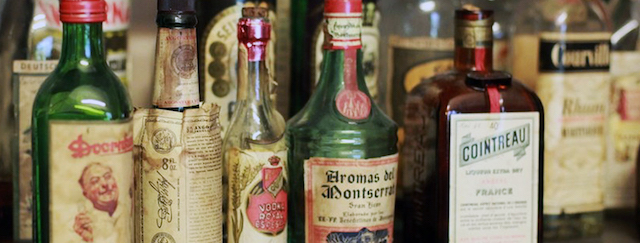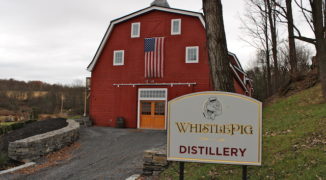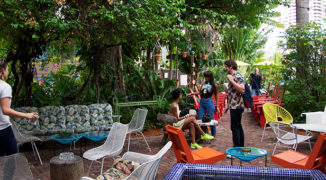Preussische Spirituosen Manufaktur, a spirits distillery in the Berlin neighborhood of Wedding, dates all the way back to 1874. The distillery was set up according to an order by the Prussian cabinet, initially as a research and training institute for alcohol production. The distillery has retained its important educational purpose—it’s the only place in Germany where you can undertake a Masters in Distillery. Today it’s more than just a historic location, it’s a unique combination of distillery, learning institute, shop and tourist attraction with detailed guided tours (and perhaps most appealingly, ample tastings).
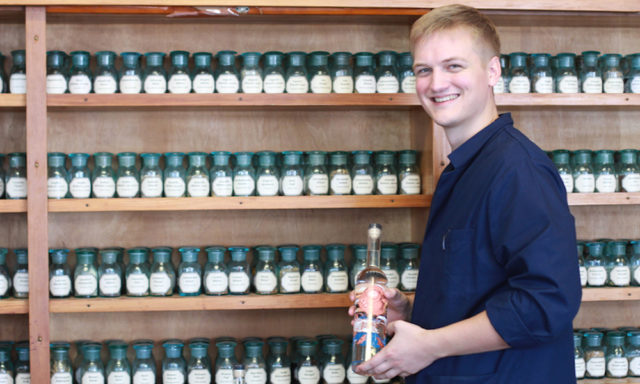 Julian Machinek, an apprentice at the distillery, with the distillery’s huge collection of herbs, spices, roots, rinds and other botanicals. All photos by Elizabeth Rushe.
Julian Machinek, an apprentice at the distillery, with the distillery’s huge collection of herbs, spices, roots, rinds and other botanicals. All photos by Elizabeth Rushe.
PSM has long since led the way in German distilling. The book regarded as the German distiller’s bible, “Trinkbranntweine und Liköre,” was photographed at the PSM distillery and published in 1964, according to Julian Machinek, an apprentice of two years at the distillery. “The pictures were taken here, this was the place to be if you wanted to be a distiller. Every distiller came from this spot,” Julian tells me. Next February, he will earn his journeyman papers, certifying that he has graduated from his apprenticeship, and can go on to become a master craftsman in distillery.
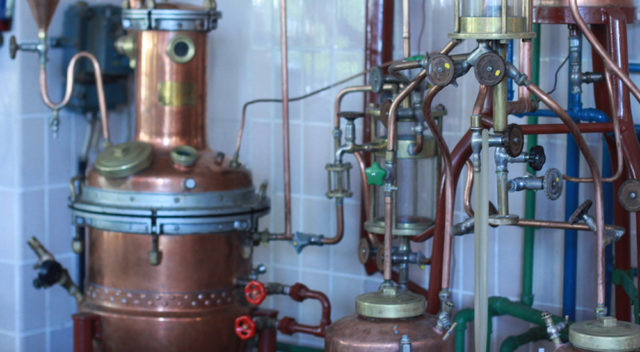 The vacuum distillation process allows delicate botanicals to maintain their flavor, rather than degrade under high heat. This still dates back to 1952.
The vacuum distillation process allows delicate botanicals to maintain their flavor, rather than degrade under high heat. This still dates back to 1952.
Stepping into the main rooms of the distillery, something is bubbling furiously over a Bunsen burner. They’re checking the proof on a new batch of liquor, distilled by Julian. A well-stocked cabinet of over 200 “drogen duftorgel” — leaves, herbs, spices, rinds and seeds for use in macerations — presides over the room. Every step of the process from creating extracts to maceration, distillation, bottling and labeling takes place under the roof of the PSM distillery. Each stage is executed by hand, and nothing is brought in from suppliers.
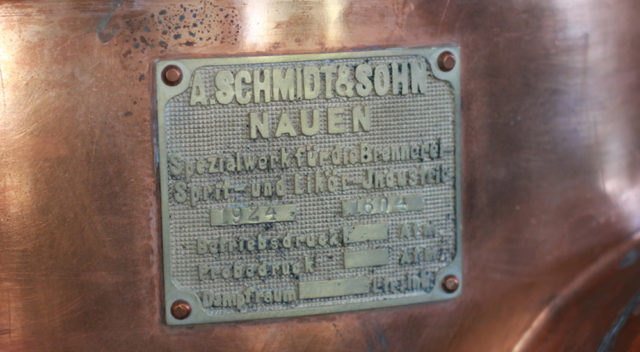 A copper still dating back to 1924.
A copper still dating back to 1924.
PSM uses more than 100 years of experience to inform their process and products. In the distillation room, Julian points to the vacuum distiller from 1952. “This one is especially suitable for maintaining flavors because it distills under a vacuum, [so] the boiling point is lower.” A table nearby is laden with bottles ranging in size and color, containing the macerations and distillations made on-site: rosehip, buffalo grass and orange blossom; the range of recipes points to a long heritage of inventiveness.
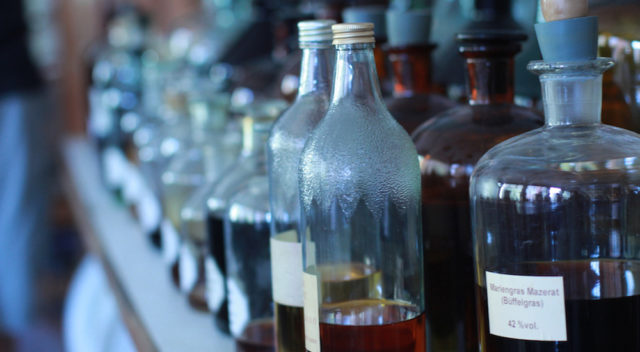 The distillery has a dizzying array of spirits, tinctures and elixirs reminiscent of an apothecary’s wares.
The distillery has a dizzying array of spirits, tinctures and elixirs reminiscent of an apothecary’s wares.
PSM not only creates their own lines of gin, vodka and liqueurs; they also collaborate with the Michelberger Hotel, a popular design hotel in Kreuzberg in East Berlin, for the “Michelberger Booze Company Ltd” range. The line includes two herbal schnapps: “Michelberger Forest,” a mellow and warm blend, and “Michelberger Mountain,” a crisp spirit likened to that feeling of invigorating fresh air that hits you as you ascend the top of a mountain.
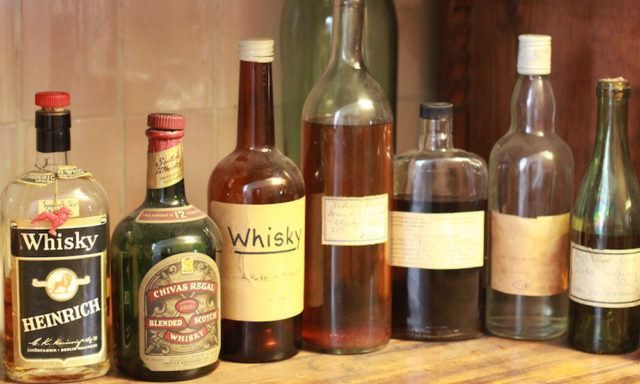 An array of vintage bottles from Prussian Spirits’ archives.
An array of vintage bottles from Prussian Spirits’ archives.
In addition to creating custom products, the PSM distillery can also recreate blends for customers who struggling with the plight of a nearly finished, unidentified bottle of mystery booze. The mint liqueur currently in the PSM range came about when a customer approached the distillery with an old bottle, with a request to ‘rebuild’ it so that he could continue to enjoy it. “He asked us, ‘Can you recreate this? I don’t know what it’s called, or where it came from, but I can’t go on living without it,’” Julian says. PSM took on the challenge, and the results were so good they decided to include the liqueur in their own product line. “You can come to us with an image, a feeling, or memory of a smell… they can stay with you for your whole life,” explains Julian—he knows the value of nostalgia in his business. And this is one of the requirements of a master craftsman in a distillery, the ability to break down the flavors and aromas of a particular alcohol and pinpoint the exact ingredients.
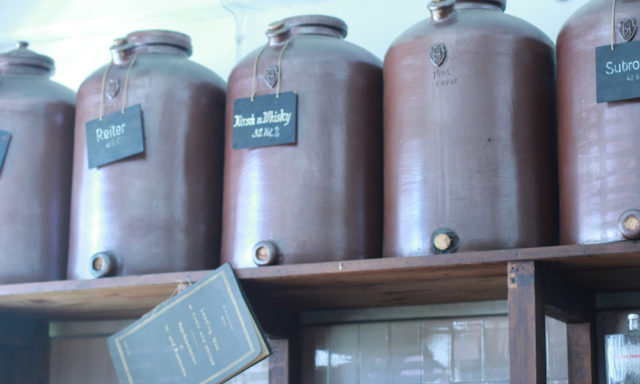 Earthenware casks, where all of Prussian Spirits’ concoctions age (or “rest”) for several months.
Earthenware casks, where all of Prussian Spirits’ concoctions age (or “rest”) for several months.
In the lower level of the distillery there are large earthenware casks with a capacity of more than 200 liters, where the spirits “rest” from three to eight months for the final stage of distillation. “It’s like a ‘finding’ process, not comparable to wooden cask storage with whiskey for example, which would give a flavor,” says Julian. “The spirits are still working in a wooden vessel… in the earthenware cask the spirits are resting, finding harmony.” One of the oldest spirits, the Adler gin, has been produced here since 1874 and spends 8 months “finding harmony” in its earthenware cask before being bottled. Once the resting period is over, the spirits are pumped out, hand bottled, sealed and labeled in this room.
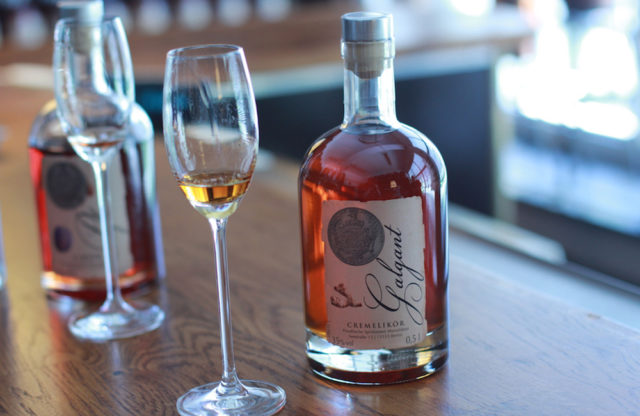 Liqueur made from galangal, an earthy, spicy root akin to ginger.
Liqueur made from galangal, an earthy, spicy root akin to ginger.
The final stop at the distillery is a bar with fully stocked shelves of the current PSM range of spirits: vodka, gin, the liqueur range including fiery galangal, quince, sweet plum, coffee and nut liqueur; Kurfürstlicher “tummy bitters” and gold-flecked spice liqueur based on a recipe dating back to the 17th century and containing 17 different spices, herbs, citrus distillate and gold leaf. You can taste and buy bottles here, as well as peruse display shelves of historical booze — the distillery has a trove of bottles dating back to the 1950s, discovered in the basement when the new owners took over.
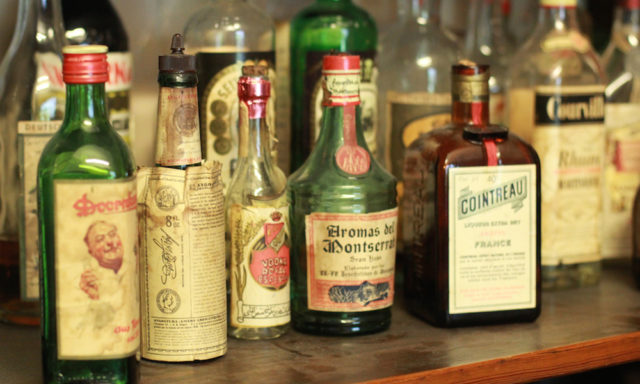 Prussian Spirits has entire shelves of vintage spirits on display, many dating back to the 1950’s.
Prussian Spirits has entire shelves of vintage spirits on display, many dating back to the 1950’s.
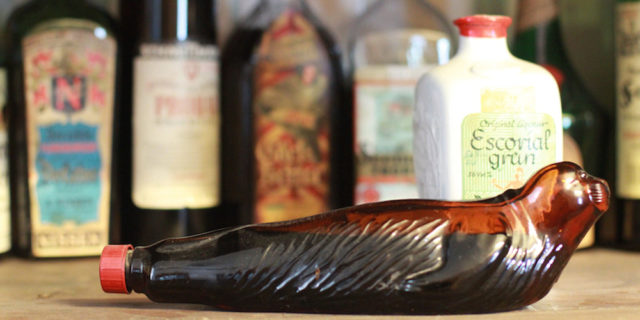 For spirits historians and collectors of vintage bottles, Prussian Spirits is more like a museum than a distillery.
For spirits historians and collectors of vintage bottles, Prussian Spirits is more like a museum than a distillery.
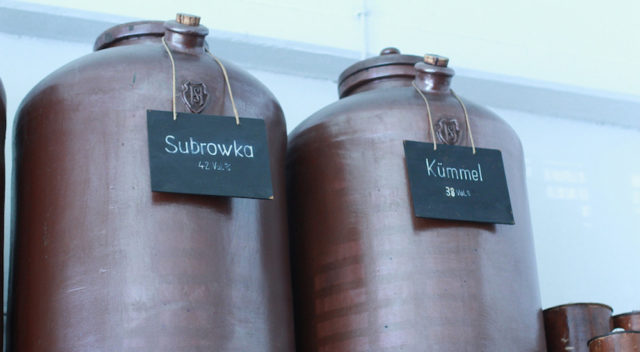 Prussian Spirits’ earthenware casks, where spirits “rest” for three to eight months. These are filled with subrowka (herbal vodka) and kümmel (a caraway liqueur).
Prussian Spirits’ earthenware casks, where spirits “rest” for three to eight months. These are filled with subrowka (herbal vodka) and kümmel (a caraway liqueur).
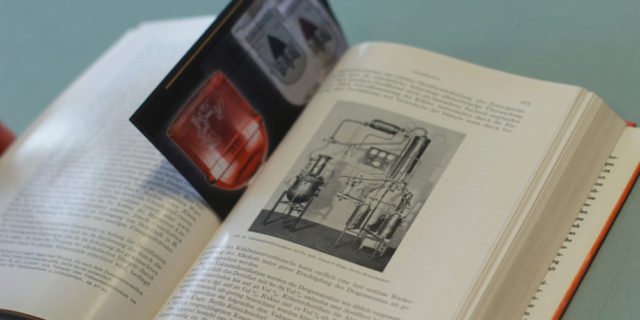 An edition of “Trinkbranntweine und Liköre,” often referred to as the German distiller’s bible. Published in 1964, it features photography from the Prussian Spirits distillery.
An edition of “Trinkbranntweine und Liköre,” often referred to as the German distiller’s bible. Published in 1964, it features photography from the Prussian Spirits distillery.
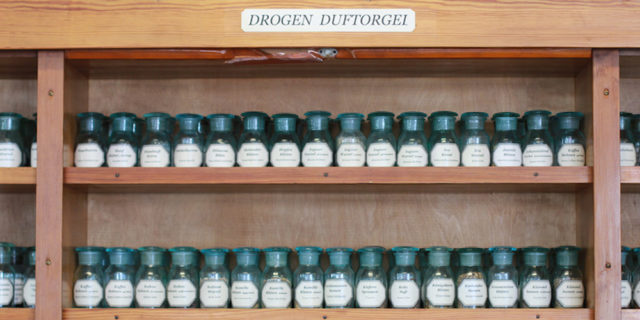 The distillery’s drogen duftorgel cabinet houses more than 200 botanicals used in various spirits.
The distillery’s drogen duftorgel cabinet houses more than 200 botanicals used in various spirits.
You can experience Preussische Spirituosen Manufactur through consuming any of their varied products or by touring the historic facility. In either case, you’ll notice superiority and expertise that comes only with time.


